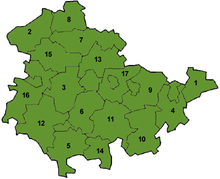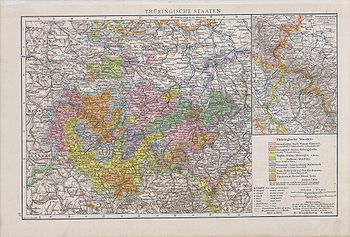- Thuringia
-
For steamships named Thuringia, see SS Thuringia."Thüringen" redirects here. For the municipality in Austria, see Thüringen, Austria.
Free State of Thuringia
Freistaat Thüringen— State of Germany — 
Flag
Coat of armsCoordinates: 50°51′40″N 11°3′7″E / 50.86111°N 11.05194°E Country Germany Capital Erfurt Government – Minister-President Christine Lieberknecht (CDU) – Governing parties CDU / SPD – Votes in Bundesrat 4 (of 69) Area – Total 16,171 km2 (6,243.7 sq mi) Population (2010-12-31)[1] – Total 2,235,025 – Density 138.2/km2 (358/sq mi) Time zone CET (UTC+1) – Summer (DST) CEST (UTC+2) ISO 3166 code DE-TH GDP/ Nominal € 44.8 billion (2005)[citation needed] NUTS Region DEG Website thueringen.de The Free State of Thuringia (German: Freistaat Thüringen, pronounced [ˈfʁaɪʃtaːt ˈtyːʁɪŋən], English /θjʊərˈrɪndʒiə/) is a state of Germany, located in the central part of the country. It has an area of 16,171 square kilometres (6,244 sq mi) and 2.29 million inhabitants, making it the sixth smallest by area and the fifth smallest by population of Germany's sixteen states. Most of Thuringia is within the watershed of the Saale, a left tributary of the Elbe. Its capital is Erfurt.
Thuringia has been known by the nickname of "the green heart of Germany" (das grüne Herz Deutschlands) from the late 19th century,[2] due to the dense forest that covers the terrain.
Thuringia is well known in Germany for nature and winter sports. It is home to the Rennsteig, Germany's most famous hiking trail, and the winter resort of Oberhof. Germany won more Winter Olympics gold medals than any other country in the last 20 years, and half of Germany's gold medals have been won by Thuringian athletes.[3]
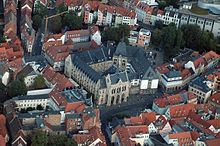 Erfurt, capital of Thuringia.
Erfurt, capital of Thuringia.
Contents
Geography
From the northwest going clockwise, Thuringia borders on the German states of Lower Saxony, Saxony-Anhalt, Saxony, Bavaria and Hesse. The ridges of the western Harz Mountains divide the region from Lower Saxony on the north-west, while the eastern Harz similarly separates Thuringia from the state of Saxony-Anhalt to the north-east. To the south and southwest, the Thuringian Forest effectively separates the ancient region of Franconia, now the northern part of Bavaria, from the rolling plains of most of Thuringia. The central Harz range extends southwards along the western side into the northwest corner of the Thuringian Forest region, making Thuringia a lowland basin of rolling plains nearly surrounded by ancient somewhat-difficult mountains. To the west across the mountains and south is the drainage basin of the Rhine River.
The most conspicuous geographical feature of Thuringia is the Thuringian Forest, a mountain chain in the southwest. The Werra River, a tributary of the Weser River, separates this mountain chain from the volcanic Rhön Mountains, which are partially in Thuringia, Bavaria, and Hesse. In the northwest, Thuringia includes a small part of the Harz. The eastern part of Thuringia is generally a plain. The Saale River runs through these lowlands from south to north.
The geographic center of the Federal Republic is located in Thuringia, near the municipality of Niederdorla.
See also List of places in Thuringia.
Thuringia is divided into 17 districts (Landkreise):
Furthermore there are six urban districts (not numerated in the map):
Each of the urban districts contains a town of the same name (see table below, "Towns in Thuringia").
Towns
Towns in Thuringia position town inhabitants district 31 December 1970 31 December 2000 30 June 2005 1. Erfurt 192.679 200.564 202.590 independent city 2. Gera 106.841 112.835 104.737 independent city 3. Jena 85.169 99.893 102.201 independent city 4. Weimar 63.985 62.425 64.361 independent city 5. Gotha 57.256 48.376 47.045 Gotha 6. Eisenach 50.059 44.442 37.858 independent city 7. Nordhausen 42.018 45.633 43.781 Nordhausen 8. Suhl 28.177 48.025 43.202 independent city 9. Altenburg 47.497 41.290 38.203 Altenburger Land 10. Meiningen 34.876 32.240 37.642 Schmalkalden-Meiningen 11. Mühlhausen 46.135 38.695 37.480 Unstrut-Hainich-Kreis 12. Saalfeld 31.048 29.511 28.148 Saalfeld-Rudolstadt 13. Ilmenau 19.634 27.176 26.713 Ilm-Kreis 14. Arnstadt 27.368 27.220 25.828 Ilm-Kreis 15. Rudolstadt 30.087 27.528 25.584 Saalfeld-Rudolstadt 16. Apolda 29.754 25.899 24.684 Weimarer Land 17. Greiz 39.424 26.177 24.007 Greiz 18. Sonneberg 29.811 24.837 23.928 Sonneberg 19. Sondershausen 22.195 23.088 21.718 Kyffhäuserkreis 20. Sömmerda 15.959 21.977 20.885 Sömmerda 21. Leinefelde-Worbis
(formed on 16 March 2004)4.315 (LF)
3.401 (WO)15.056 (LF)
5.497 (WO)20.816 Eichsfeld 22. Bad Langensalza 16.813 19.917 18.760 Unstrut-Hainich-Kreis 23. Schmalkalden 14.527 18.551 17.893 Schmalkalden-Meiningen 24. Zeulenroda-Triebes
(formed on 1 March 2006)13.549 (ZR)
4.790 (TR)14.600 (ZR)
4.230 (TR)17.702 Greiz 25. Heiligenstadt 12.464 17.291 17.175 Eichsfeld 26. Bad Salzungen 11.466 17.086 16.551 Wartburgkreis 27. Pößneck 19.547 14.341 13.592 Saale-Orla-Kreis 28. Schmölln 13.968 13.193 12.693 Altenburger Land 29. Zella-Mehlis
(formed on 1 April 1919)17.136 13.036 12.355 Schmalkalden-Meiningen 30. Hildburghausen 10.652 12.466 12.351 Hildburghausen 31. Eisenberg 13.859 11.764 11.489 Saale-Holzland-Kreis 32. Waltershausen 14.219 11.725 11.307 Gotha History
Duchy (Landgraviate) of Thuringia
Herzogtum (Landgrafschaft) ThüringenPagan kingdom, Frankish duchy,
then State of the Holy Roman Empire450–1247  →
→
 →
→Capital Not specified Government Principality Historical era Middle Ages - Thuringian kingdom
established
before 450- Frankish invasion;
duchy established
632- Landgraviate established 1130 - Comital line extinct 1247 - War of the Thuringian
Succession
1247–64For the earlier history of the region, see Thuringii and Duchy of Thuringia.Named after the Thuringii tribe who occupied it ca. AD 300, Thuringia came under Frankish domination in the 6th century, forming a part of the subsequent Holy Roman Empire.
Thuringia became a landgraviate in 1130. After the extinction of the reigning Ludowingian line of counts in 1247 and the War of the Thuringian Succession (1247–1264), the western half became independent under the name of Hesse, never to become a part of Thuringia again. Most of the remaining Thuringia came under the rule of the Wettin dynasty of the nearby Margraviate of Meissen, the nucleus of the later Electorate and Kingdom of Saxony. With the division of the house of Wettin in 1485, Thuringia went to the senior Ernestine branch of the family, which subsequently subdivided the area into a number of smaller states, according to the Saxon tradition of dividing inheritance amongst male heirs. These were the "Saxon duchies", consisting, among others, of the states of Saxe-Weimar, Saxe-Eisenach, Saxe-Jena, Saxe-Meiningen, Saxe-Altenburg, Saxe-Coburg, and Saxe-Gotha; Thuringia became merely a geographical concept.
Thuringia generally accepted the Protestant Reformation. The Catholic faith was abolished as early as 1520; priests that remained loyal were driven away and churches and monasteries were largely destroyed, especially during the German Peasants' War of 1525. In Mühlhausen and elsewhere, the Anabaptists found many adherents. Thomas Müntzer, a leader of some non-peaceful groups of this sect, was active in this city. Within the borders of Thuringia the Catholic faith was maintained only in the district called Eichsfeld, which was ruled by the Archbishop of Mainz, and to a small degree in the city and vicinity of Erfurt.
 This German map shows the various states of Thuringia within the German Empire in 1905.
This German map shows the various states of Thuringia within the German Empire in 1905.
Some reordering of the Thuringian states occurred during the German Mediatisation from 1795–1814, and the territory was included within the Napoleonic Confederation of the Rhine organized in 1806. The 1815 Congress of Vienna confirmed these changes and the Thuringian states' inclusion in the German Confederation; the Kingdom of Prussia also acquired some Thuringian territory and administered it within the Province of Saxony. The Thuringian duchies which became part of the German Empire in 1871 during the Prussian-led unification of Germany were Saxe-Weimar-Eisenach, Saxe-Meiningen, Saxe-Altenburg, Saxe-Coburg-Gotha, Schwarzburg-Sondershausen, Schwarzburg-Rudolstadt and the two principalities of Reuss Elder Line and Reuss Younger Line. In 1920, after World War I, these small states merged into one state, called Thuringia; only Saxe-Coburg voted to join Bavaria instead. Weimar became the new capital of Thuringia. The coat of arms of this new state was simpler than they had been previously.
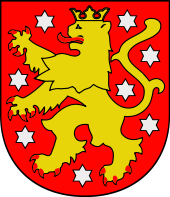 Coat of arms used 1945–1952
Coat of arms used 1945–1952
After briefly being controlled by the USA, from July 1945, the state of Thuringia came under the Soviet occupation zone, and was expanded to include parts Prussian Saxony, such as the areas around Erfurt, Mühlhausen, and Nordhausen. Erfurt became the new capital of Thuringia.
In 1952, the German Democratic Republic dissolved its states, and created districts (Bezirke) instead. The three districts that shared the territory of Thuringia were based in Erfurt, Gera and Suhl.
The State of Thuringia was restored with slightly altered borders during Germany's reunification in 1990.
Politics
List of Minister-presidents of Thüringen
Main article: List of Ministers-President of ThuringiaAugust 30, 2009 state election
See also: Thuringia state election, 2009Summary of the 30 August 2009 election results for the Landtag of Thuringia Party Party list votes Vote % (change) Total Seats (change) Seat % Christian Democratic Union (CDU) 329,241 31.2% (−11.8) 30 (−15) 34.1% The Left 288,932 27.4% (+1.3) 27 (−1) 30.7% Social Democratic Party (SPD) 195,353 18.5% (+4) 18 (+3) 20.5% Free Democratic Party (FDP) 80,511 7.6% (+4) 7 (+7) 8.0% Alliance '90/The Greens (Grüne) 64,889 6.2% (+1.7) 6 (+6) 6.8% National Democratic Party (NPD) 45,401 4.3% (+2.7) – – Free Voters in Thuringia 40,834 3.9% (+1.3) – – All Others 9,040 0.8% – – Totals 1,054,201 100.0% 88 100.0% Turnout was 56.2%. SPD and CDU formed a coalition seven weeks after the election.[4]
Religion
Evangelical Church in Germany 25.1 %,[5] Catholic Church 7.8 %.[6]
Transportation
- Autobahn: A4, A9, A38, A44, A71, A73
- Airports: Altenburg-Nobitz Airport, Erfurt Airport
See also
- Rulers of Thuringia
- Thüringer sausage
References
- ^ "Bevölkerung nach Gemeinden, erfüllenden Gemeinden und Verwaltungsgemeinschaften" (in German). Thüringer Landesamt für Statistik. 31 December 2010. http://www.statistik.thueringen.de/datenbank/TabAnzeige.asp?tabelle=gg000102%7C%7C.
- ^ A. Trinius (1898)
- ^ http://www.leg-thueringen.de/index.php?id=1982&L=1
- ^ CDU and SPD form Thuringia state coalition, The Local; 19 October 2009.
- ^ EKD http://www.ekd.de/download/kirchenmitglieder_2007.pdf
- ^ chiesa cattolica http://www.dbk.de/imperia/md/content/kirchlichestatistik/bev-kath-l__nd-2008.pdf
External links
- Official government site
- Tourist website for Thuringia (German)
- Official Directory (German)
- Another Tourist website for Thuringia
- Historical Overview
- Tourist website with many pictures of thuringian landscapes (German)
- Alternative Tourist website for Thuringia (German) (English)
- Thuringia at the Open Directory Project
- Thuringian flags at [note 1] and [note 2]
- Search engine for Thuringia with videos (German)
- ^ "Thuringia (Germany)". Fotw.vexillum.com. http://fotw.vexillum.com/flags/de-th.html. Retrieved 2010-05-22.
- ^ Marcus Schmöger. "Thüringen". Flaggenkunde.de. http://www.flaggenkunde.de/deutscheflaggen/de-th.htm. Retrieved 2010-05-22.
 States of the Federal Republic of Germany
States of the Federal Republic of GermanyStates  Baden-Württemberg (since 1952)
Baden-Württemberg (since 1952) Bavaria (since 1949)
Bavaria (since 1949) Brandenburg (since 1990)
Brandenburg (since 1990) Hesse (since 1949)
Hesse (since 1949) Lower Saxony (since 1949)
Lower Saxony (since 1949) Mecklenburg-Vorpommern (since 1990)
Mecklenburg-Vorpommern (since 1990) North Rhine-Westphalia (since 1949)
North Rhine-Westphalia (since 1949) Rhineland-Palatinate (since 1949)
Rhineland-Palatinate (since 1949) Saarland (since 1957)
Saarland (since 1957) Saxony (since 1990)
Saxony (since 1990) Saxony-Anhalt (since 1990)
Saxony-Anhalt (since 1990) Schleswig-Holstein (since 1949)
Schleswig-Holstein (since 1949) Thuringia (since 1990)
Thuringia (since 1990)

City-states Former states  Baden (south) (1949–1952)
Baden (south) (1949–1952) Württemberg-Baden (1949–1952)
Württemberg-Baden (1949–1952) Württemberg-Hohenzollern (1949–1952)
Württemberg-Hohenzollern (1949–1952)
 Urban and rural districts in the Free State of Thuringia in Germany
Urban and rural districts in the Free State of Thuringia in Germany 
Urban districts Rural districts Altenburger Land · Eichsfeld · Gotha · Greiz · Hildburghausen · Ilm-Kreis · Kyffhäuserkreis · Nordhausen · Saale-Holzland-Kreis · Saale-Orla-Kreis · Saalfeld-Rudolstadt · Schmalkalden-Meiningen · Sömmerda · Sonneberg · Unstrut-Hainich-Kreis · Wartburgkreis · Weimarer Land States of Germany during the Weimar Republic (1919–33)
States of Germany during the Weimar Republic (1919–33)States Anhalt · Baden · Bavaria · Brunswick · Hesse · Lippe · Mecklenburg-Schwerin · Mecklenburg-Strelitz · Oldenburg · Prussia · Saxony · Schaumburg-Lippe · Thuringia (from 1920) · Waldeck (until 1929) · Württemberg
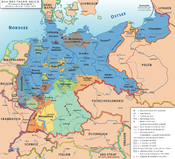
City-states Until 1920 Elder · JuniorUnofficial Categories:- Former principalities
- Former countries in Europe
- States of the Holy Roman Empire
- States and territories established in 450
- States and territories disestablished in 1247
- Thuringia
- States of Germany
- States of the Weimar Republic
- NUTS 1 statistical regions of the European Union
- 1130 establishments
- States and territories established in 1920
- 1952 disestablishments
- States and territories established in 1990
- States and territories established in 632
Wikimedia Foundation. 2010.




